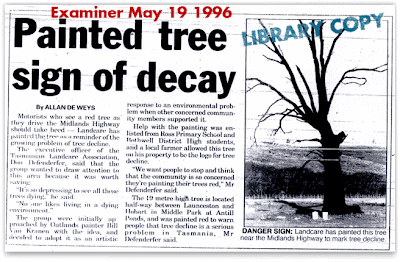
CLICK ON THE IMAGE TO ENLARGE
In postmodernism and 'art' everything is quotable and open to appropriation. Art about art throws up all kinds of difficulties but here we have The Red Tree – actually its the REDreadTREE – characterised as, reinvented as, a symbol of "renewal" – "I've been using the red tree for quite a number of years - it is really about renewal and change'' Many Hunniford, Examiner March 2 2012.
Actually, this Landcare Landmark aimed to draw attention to degradation and the unexplained phenomena of 'Rural Tree Decline' in Tasmania's Midlands. It also set out to promote the concept of LANDliteracy that was in the mid 1990s gaining some currency. Interestingly, in the Decade of Landcare there was a net loss of tree cover in Tasmania's Midlands despite the planting of thousands upon thousands of trees in an attempt to turn back Rural Tree Decline.
Any claim that this installation was about anything more than the hope for renewal is folly and yet more smoothed over history – something akin climate change denial. The REDread TREE did however win the attention of a researcher who ultimately told the unhappy story of the Midlands' degradation and over exploitation.
The degradation continues and GOOGLEearth tells us that the exploitation grows apace. What the future holds is an open question but "renewal" hardly seems likely but there you go. Nonetheless, “the tragedy of life doesn’t lie in not reaching your goal. The tragedy lies in having no goals to reach.” ~ Benjamin Mays
To see T-R-E-EreadRED Landcare Story CLICK HERE
THIS STORY'S SOURCE ONLINE: http://www.examiner.com.au/news/local/news/general/historic-coach-house-reinvented-as-gallery/2474434.aspx

























